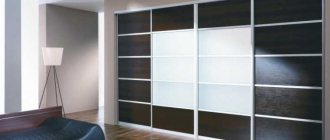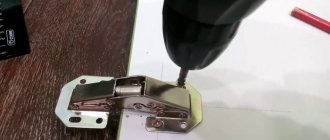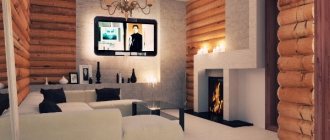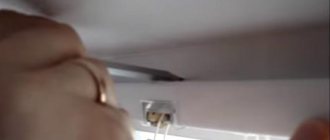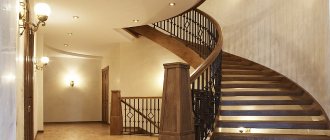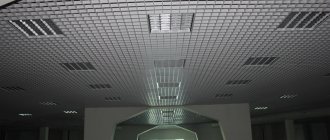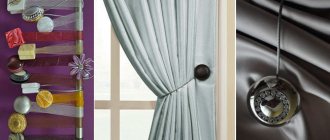Open wiring is the easiest way to lay electrical lines. This type differs from the hidden one in that the cables pass above the thickness of the building structure, and not inside. The process is less labor-intensive, as it allows you to do without gating the walls. It is difficult to find such wiring in multi-storey buildings, but the method is relevant for cottages, houses or premises in retro style.
Advantages and disadvantages of open wiring
The advantages include the following:
- Easy to install . Compared to the hidden installation method, open installation takes less time and allows you to equip the system with your own hands.
- Price . The cost of installation is significantly less, since multiple grooves around the perimeter of the room are eliminated.
- Mobility of layout . At any time, if the need arises, you can move the switch or socket to another location without effort.
- Availability . In the event of a malfunction, replacing a non-functioning element or assembly is carried out without difficulty.
The disadvantages are as follows:
- Appearance . Not everyone will like the lines of wires laid throughout the house, with the exception of pre-conceived design solutions.
- Fire safety . If the wiring is looked after, it can be replaced very quickly. The main thing is to be careful and prevent damage. In addition, fire safety in wooden houses requires special vigilance from owners.
What are the advantages of the method
Open cable routing along walls is most often used not in houses and apartments, but in garden buildings in the country - a garage, a utility block, a bathhouse. Although if you try and choose the right materials, then even in private houses and modern apartments this option for installing electrical wiring will be a winner.
The advantages of open wiring are as follows:
- simpler and faster installation, which even a novice electrician can easily handle;
- fewer tools and materials will be required than when creating hidden electrical wiring;
- You can bring out a new group of wires from the panel or distribution box at any time (for example, if you want to install another socket);
- in some cases, this option has a positive effect on the interior of the room (for example, if you use porcelain rollers and insulators in the bathhouse);
- Repair and maintenance of the line can be carried out without disturbing the decorative finish of the walls.
At the same time, the disadvantages of installing open wiring with your own hands are an increased risk of fire, limited operating conditions and a shorter service life of the electrical network. Please also take into account that the route is more susceptible to mechanical damage than if it is laid in walls.
Do not lay open electrical wiring in the kitchen so that water and heat from the stove enter the cable lines and sockets, also follow the recommendations described in the article on installing sockets in the kitchen.
In addition, read the rules for laying external electrical wiring on combustible substrates in the article: electrical wiring in a wooden house. In general, it is necessary to ensure a minimum probability of fire; for this you need to use a VVGng-LS cable, modern electrical installation products and installation tools that do not support combustion.
Open wiring in a private house
Requirements for external wiring in the apartment
First of all, it is necessary to draw up an electrical diagram of lines and elements: sockets, switches and boxes. When drawing up a project, you need to consider the following points:
- Wiring lines must be located vertically or horizontally relative to the planes of the room. Other options are prohibited by safety regulations.
- According to standards, they should lie at a distance of 15-20 cm from corners, window and door openings. Distance from floor level: sockets at least 20 cm, and switches - 60 cm.
- Do not lay cables near batteries, heaters and other elements of heat radiation. The insulating layer becomes unusable due to constant temperature and the risk of an emergency increases to a critical state.
- It is also prohibited to install electrical components under pipes where condensate accumulates.
- For rooms with high humidity, electrical wiring elements must have double or triple insulation.
- Connections and wire assemblies should only be located in junction boxes.
- In advance, on the diagram, place the distribution box in an easily accessible place.
If the system is not laid through pipes or protective panels, then special brackets are used, sold in specialized stores. They are necessary to prevent the wires from sagging under their own weight. The distance between horizontal type wiring brackets is every 30-40 cm, and for vertical ones - 60 cm.
Pros and cons of external wiring
Therefore, the first and main advantage of external wiring in an apartment is the speed of its installation. For example, you can install exposed wiring in a one-room apartment with your own hands, without much experience, in a couple of days. A professional hired electrician can do it in five to six hours.
The second advantage is that for open wiring you do not need to groove the walls, make channels in them for laying wires and sockets for sockets, switches and junction boxes, and then, after installation, re-plaster, paint or wallpaper the walls.
The third plus is that open wiring is always available. You can repair the damaged area or add some new elements to the wiring at any time without much effort. For example, run another branch to a new lamp, install a new additional one, or move an old socket to another location. With hidden wiring, such a number will not work: you will have to drill into the walls.
But open wiring also has its disadvantages.
The first disadvantage is that exposed wiring is always visible, and it does not look harmonious in all interiors. Unless you are making an interior in country, retro, techno or steampunk style. In this case, exposed wiring can be a highlight.
The second disadvantage is that you must clearly take into account the technical standards of the room in which you are doing open wiring. For example, in the bathroom, kitchen and other rooms with high humidity, even for hidden wiring, you need to use additional wire protection and install devices (switches, sockets) with a protection class of at least IP-44, and for open wiring - at least IP-68. But they don’t always look beautiful and attractive.
What is needed to install open wiring
How to choose a cable
The cable must be selected based on the upcoming electrical load. For home electrical and lighting devices, a 2-3-core copper or aluminum cable with a cross-section of 2.5 mm will be sufficient. A household electric stove is connected with a cable with a cross-section of 4-6 mm, and the branch is connected to a separate 25A fuse in the junction box.
When choosing between copper and aluminum cable, most people prefer copper because it:
- Corrosion resistant;
- withstands electrical loads with the same cross-section as aluminum;
- plastic, which allows you to lay the system without the risk of breaking the cable.
Sockets
Sockets for open wiring are called overhead because they are attached to the wall in any desired place. Unlike submersible ones, their contacts are located inside and they are completely isolated.
As with submersible sockets, sockets with a grounding contact are suitable for grounded electrical networks.
If the socket does not complete the circuit and the power wire goes from it to the next one, then it is called a pass-through socket. They are installed with a boxless connection.
Switches
Sealed switches are not a purposeful design for open-type wiring. Often, having a hidden cable system, they install closed switches. This is done in places of high humidity to avoid short circuits and prevent emergency situations.
Installation is the same as for open wiring sockets - a couple of holes in the wall and the switch is securely held in the right place.
Installation
The wires are connected in special boxes and distribution blocks. The piece that goes into the boxes should be bitten off with a small margin, 60-65 mm will be enough. If over time the contact deteriorates or burns, you can easily cut out the damaged cable and restore the connection. At the exits from the distribution boxes, at a distance of about 50 mm, the conductors are attached to the walls.
All sockets and switches are installed on a special substrate, the thickness of which should be 10 mm greater than the thickness of the walls of the product. If sockets or switches of old types are installed, then such a gasket can be cut out of wood or plastic yourself. First, a base is attached to the wall surface, and then the product is installed on it.
All rules and recommendations were compiled by highly qualified specialists and are aimed at ensuring the safe operation of the electrical network. If you decide to install open wiring yourself, then knowledge of these requirements is mandatory.
Installation methods
There are several ways to lay open wires. When choosing, you need to take into account the type of room - cable channels are suitable for an office, while renovations in a designer style will require installation through a baseboard or decorative tubes.
External wiring in cable duct
The cable-duct method of laying wires is more often used, as they have important performance properties:
- non-toxic;
- temperature resistant;
- have a low price.
Attached to walls using dowels or glue (depending on the surface). Inside the cables there are channel separations for several wires. Cover the top with a lid. Plugs and corners of network elements are included in the kit or can be purchased separately. They are made in a variety of styles and colors, so they are suitable not only for offices, but will also fit well into any room design. The main thing is to choose the right type and color.
Open wire
One of the most common and oldest methods. Previously, this was done through a bent cambric, which was nailed to the surface with small nails. Now it has been replaced by plastic staples, which are sold with nails inside. The main thing is to choose the correct size of the bracket so as not to pinch the cable, breaking the insulating layer. The location is the same - every 10 cm. If several wires pass nearby, the distance between them should be at least 4-5 mm.
What kind of wiring does your home have?
Open
Closed
Wiring through the baseboard
A suitable way to maintain the appearance of a room. This type of wiring differs from a regular baseboard in the presence of several channels and the installation method.
The base is first attached to the wall around the perimeter of the floor. The necessary wires are pulled along special guides inside the baseboard and covered with a lid. Outwardly, it is no different from an ordinary construction plinth, not counting the plastic guides for sockets and switches, the same as in the version with cable channels.
Design and color options are selected directly by the buyer.
In the pipes
Modern industry allows wiring to be laid in different ways that meet fire safety requirements. Corrugated pipe is often used for this.
But the installation method in pipes is a labor-intensive process. The wire is attached to a rope, which is pulled inside the pipes, and after the end of the rope comes out, the cables are pulled.
The diameter of the pipe should be twice the diameter of the wires in the bundle. Fastening to surfaces is done using special clips. When dismantling, it will be enough to pull one end of the pipe. The corrugation itself is equipped with metal threads inside, which allows it to maintain its shape when bending.
In addition to corrugation, there are several other types of material for making pipes, but they are rare and in terms of parameters are much inferior to corrugated ones, even in weight. And the weight of the wiring is an important detail, so the lighter it is, the better.
Stylish wiring in retro and loft styles
With an emphasis on effectiveness and pronounced interior elements, they use the installation method through ceramic insulators and metal decorative pipes.
The very first wiring was laid in this way. In old village houses, open wiring is still installed. The fashion for them is coming back again. Two wires are intertwined with each other and stretched along the perimeter of the room, periodically bending around the ceramic insulators. For safety reasons, insulating rollers are mounted at a distance of 10 cm from each other, and the twisted wire is at least 1.5 cm from the surface.
This method should be resorted to if the design of the room is made in the same style or there is no other choice, because the method with ceramic insulators is the most unsafe of all.
In another case, decorative metal pipes are used, which are made in a variety of colors and styles. During installation you will have to spend more time than with a corrugated analogue. Metal tubes are attached to the surface through special rods. They are fastened together with couplings and 90 degree angles.
Installation of wiring in rigid pipes
Recently, many people are discovering the installation of external wiring using rigid plastic pipes. In this case, the cables are placed inside the pipelines, which are then fixed to the walls on special supports. To facilitate such installation, a large number of auxiliary devices have been developed (tees, cable sleeves, T-junctions).
The main advantage of this installation is the high degree of protection of electrical conductors from exposure to water, as well as from mechanical damage.
In this regard, this installation method is most often used in cellars, garages and basements. But this does not mean that external electrical wiring cannot be laid in this way on a summer cottage, in a city apartment or a country house, since insulating pipes look quite attractive in appearance.
Features of installing open electrical wiring in IRL pipes
When laying an electrical line in insulating pipes, you need to remember some important points:
- Pipelines must be attached to the walls in such a way that the distance between them is at least 80 cm, while there must be at least 10 cm from the electrical device or element to the nearest fastener.
- Cables can only be connected to each other at the terminals of electrical components or inside special junction boxes.
Connecting conductors in pipes is unacceptable.
- The bending radius of pipelines must be at least 6 times greater than their diameter.
For this type of installation, special fixing devices are provided. A list of them can be found both on the Internet and in specialized literature.
If for some reason you cannot buy special fasteners, you can use regular construction paper tape to install insulating pipes. To do this, you need to cut a piece of the required length from the skein and secure it to the surface. The end fastenings should be made at an angle and slightly away from you so that the tape does not sag. The pipe is then secured with ties along its entire length. Sometimes, if it is impossible to get special fasteners, fastening with punched paper tape can be a completely successful solution.
An example of installing a pipeline for electrical wiring in the video:
Necessary tools for installing wiring in pipes
This installation method does not require many tools. To work you will need:
- Marking cord.
- Hammer drill (for working with concrete walls). This device will also require a drill of the required diameter.
- Plumb.
- Roulette.
- Hammer.
- Building level.
- Hacksaw for metal.
To connect in difficult areas, you will need two couplings, as well as a corrugation. The pipelines are installed in such a way that moisture does not accumulate inside them. Therefore, you need to pay special attention to the quality of the rubber seal, which is installed at the junction of the pipe and the electrical element.
It is advisable to use reinforced seals that match the diameter of the insulating pipe. When installing, the cuff should penetrate a small part of the electrical installation product.
If there is no sealing collar, it is recommended to insert the wire from below.
Advantages and disadvantages of the method
The advantages of installing electrical wiring in insulating pipes include:
- Easy to install.
- Additional protection of conductors from mechanical damage and moisture.
- Attractive appearance.
The disadvantages of this method are the following:
- It is necessary to accurately select the pipe size.
- Quite a few additional accessories are required.
In general, installing open wiring in pipes is a completely working method, which allows you to reliably protect cables from damage and give the line elegance.
Design project of retro wiring in a wooden house and apartments with photos of interiors
Retro wiring is not only stylish, but also a technologically advanced alternative to traditional cable routing in cable channels. As a rule, it is used in Provence, grunge, loft, Victorian classic, vintage, and modern interiors.
Examples of using retro wiring in the interior:
PHOTO: bossfor.org
PHOTO: media2.24aul.ru
PHOTO: 9dach.ru
PHOTO: inde.io
PHOTO: l-gallery.ru
PHOTO: r-electro.ru
Wiring in retro style - components with photos in the interior
Retro wiring, especially in a wooden house, requires a more careful approach to fire and electrical safety. When purchasing cables and components, you need to pay attention not only to the design and external data, but also to the quality, manufacturability and reliability of execution. It is most advisable to purchase products from branded manufacturers. The leading products are from Italian companies:
- Bironi ; retro wiring Bironi
- Fontini ;
retro wiring Fontini - Villaris ;
retro wiring Villaris - Aldo Bernardi ;
retro wiring Aldo Bernardi - Gl Gambarelli .
retro wiring Gl Gambarelli
Russian manufacturers are represented much less. Among the worthy companies we can name Lindas , whose products are not inferior in quality to the retro wiring elements of Bironi . Chinese goods are represented quite widely, but the quality of their products leaves much to be desired. Salvador products received the most worthy (albeit mediocre) reviews .
retro wiring Salvador
It is advisable to purchase the necessary materials from one manufacturer. For example, Lindas offers ready-made kits:
PHOTO: rs-electro.ru
PHOTO: rs-electro.ru
PHOTO: rs-electro.ru
PHOTO: rs-electro.ru
PHOTO: rs-electro.ru
PHOTO: rs-electro.ru
Lindas
Twisted retro wire
The cable for retro wiring is available in the form of stranded copper wires with a cross-section of 1.5 and 2.5 mm². Other types of sections are very rare. The wires have polymer insulation made of the following materials:
- PVC – elastic, but with low strength, used only permanently;
- elastomer - can stretch during operation, and therefore requires more frequent fastenings;
- polyurethane is durable, has mediocre elasticity, and requires bending over a large radius.
External decorative insulation (braid) is made of technical cotton or silk. Branded manufacturers impregnate the braid with fire retardant compounds or fill it with varnish. The wide range of colors and patterns on the surface of the wiring are very diverse, which allows you to choose the right option for any design solution.
An example of Bironi retro wiring products PHOTO: iskraero.ru
Retro sockets and switches for open wiring
Sockets are overhead, often have special installation frames (for 1-3 places) made of wood, metal-look plastic or ceramics. For devices that are frequently used, it is best to use ceramic ones, as they prevent heating.
Expert's point of view
Alexey Strakhov
Head of the Electricity Supply Group, GRAST LLC
Ask a Question
“Some planting frames have a radially curved base and are intended for arranging retro wiring in a wooden (log) house, although the price of such products is significantly higher than usual.”
Switches have several variants of mechanisms:
- toggle switch - more reliable and familiar to use;
- rotary - can be one, two or three-pin, thanks to which it can switch several circuits.
As a rule, sockets, switches and junction boxes are selected from one collection PHOTO: retrorosette.rf
Related article:
With the right approach and compliance with all safety basics, high-quality electrical wiring in a wooden house is carried out with your own hands . Step-by-step instructions will help you do everything correctly.
Terminal blocks and distribution boxes
Distribution boxes are used to switch wires and significantly reduce their number. Otherwise, you would have to run a wire from the terminal block to each electrical appliance or outlet. The overall dimensions of junction boxes vary:
- diameter 70-90 mm;
- height 35-55 mm.
A junction box from a technical device can turn into a decorative element PHOTO: wooood.ru
Cartridges, passages and rollers (insulators) for retro wiring
External retro wiring in a wooden house is fixed to the walls using special insulators. They look like small relief cylinders with a base diameter of 18-22 mm and a height of 18-24 mm. The upper part, the “hat,” can be narrow for mounting a two-core cable and wide for a three-core cable. Material of manufacture: plastic or porcelain. Fastening to the wall is carried out through a hole in the center using ordinary or decorative screws.
The rollers are produced in a variety of colors, often complete with other elements of electrical accessories PHOTO: razvodka.net
Passages belong to decorative and protective electrical elements. They are a decorative sleeve with a collar that covers the hole through which the cable comes out of the wall. Material of manufacture: porcelain.
Vintage cartridges are made from brass, aluminum alloys, copper, carbolite or polymer materials painted to look like metal. As a rule, their design includes a switch, as well as technological holes, threads and washers for attaching lampshades, etc.
Vintage brass socket with rotary switch PHOTO: dneprsvet.com.ua
Vintage style lighting fixtures
Professional designers, when developing a retro interior, usually create custom lighting fixtures. You can try to create them yourself by combining vintage sockets and unusually shaped decorative light bulbs with a base. An electric cable attached to several rollers is used as suspension. It is much easier, but more expensive, to purchase ready-made “retro” lighting fixtures, both ceiling lamps and chandeliers, and wall sconces.
PHOTO: i.ytimg.com
PHOTO: img01.cp.aliimg.com
PHOTO: ae01.alicdn.com
PHOTO: ae01.alicdn.com
PHOTO: cs5.livemaster.ru
PHOTO: cs5.livemaster.ru
Homemade and factory-made lamps and chandeliers, made in vintage style PHOTO: sc02.alicdn.com
Let's look at several options for open wiring using examples
Loft open wiring. This fashion trend allows you not only to be in trend, but also to save on the aesthetic component. That is, you simply lay industrial corrugation without worrying about matching the color and shape (this is the loft style). Fastenings and materials can be the cheapest, the main thing is reliability.
Although rooms decorated to order can look and be priced very expensive. But the technology for installing open electrical wiring has nothing to do with this.
Another trend that takes a lot of money is retro wiring. If you are willing to purchase expensive accessories (fiberglass braided wire costs an order of magnitude more than regular wire), you can complete the electrical installation beautifully and safely.
All fittings are made of ceramics. By the way, it is one of the best dielectrics in terms of fire safety. There is no point in organizing common harnesses and cable ducts. The vintage design just means that the more wires, the more stylish the room looks.
In addition, the retro style involves laying wires in metal pipes. For wooden premises it’s the best: it’s beautiful, it’s fireproof, and the wiring is reliably protected from mechanical stress.
And if these same pipes are also connected to protective grounding, you don’t have to worry that the wiring will pierce a phase to the pipe body.
No less aesthetically, you can organize open wiring in cable ducts. This is absolutely a classic. Initially, professional pipes were used only to optimize harnesses with a large number of wires. And today this is a way to lay single cables.
In addition, the modern design of these accessories allows the box to fit into any interior.
Do you want a contrasting white color? If not, choose a cable box with a wood finish: the choice in stores is huge.
Important! Laying wiring in a box has undeniable advantages:
- By opening the cover, you can always add a new conductor (if this does not contradict the restrictions of the PUE).
- The wires in the box can be used without an outer sheath - again, saving money.
- No ties, fastening clips, beautiful styling. The main thing is that there are no knots or kinks in the wire. The rest will be hidden under the lid.
The situation is a little more complicated with the so-called electrical skirting boards.
Important! When purchasing a similar product, check with the seller: what type of wiring can be installed in the niche of the decorative element. Otherwise, you will buy a baseboard that is not protected from fire, in which you can only install a telephone or Internet line.
With the only drawback: low capacity, a plinth for open wiring can actually replace gating.
Using this technology in conjunction with laying cables behind a suspended ceiling, you can generally leave the walls untouched. In this case, all electrical wiring will be replaced.
Advice! When laying power and signal (telephone, television, Internet) wires together in the baseboard, remember about mutual interference. Ferrite filters at the ends of the wires will not interfere.
Installation of retro wiring - price for work
The total cost of electrical wiring, including installation, is much higher than conventional wiring. However, the lion's share of financial costs falls on the purchase of materials. The work itself, although not particularly complex, must be carried out with special care, since the result will always be visible. Here are some prices as of September 2020 obtained from a number of Internet resources for the request “Installation of retro wiring price Russia”.
| Company | Cost of installation work (as of October 2019), rub. | |||
| Sockets | Switches | Junction boxes | Wire routing | |
| "Two electricians" Moscow and Moscow region | 500 | 500 | 450 | 120 |
| "Home electrician" St. Petersburg | 300 | 300 | 500 | 130 |
| "ElectroDoka" Moscow and Moscow region | 300 | 300 | 400 | 150 |
| Normogrand LLC In Moscow and surrounding regions | 300 | 300 | 450 | 100 |

